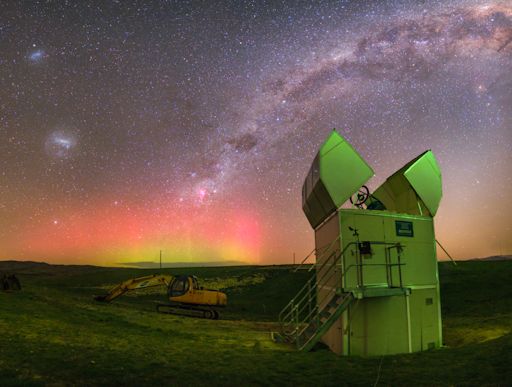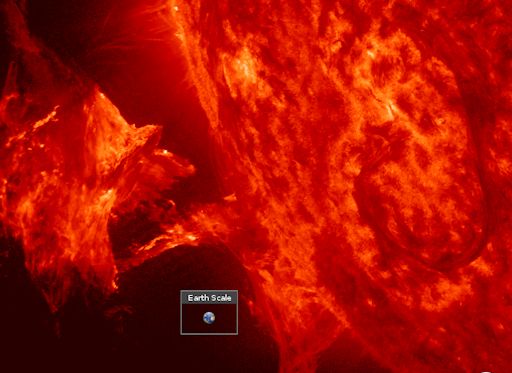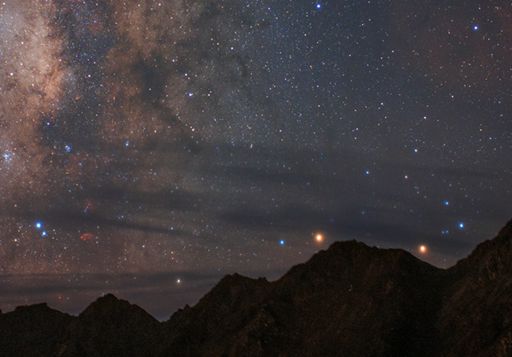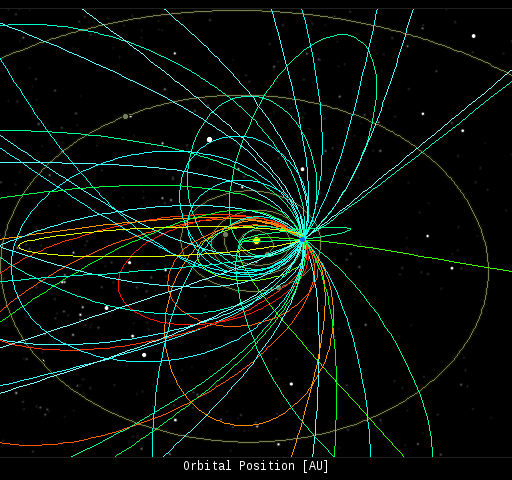On October 8th there will be a total eclipse of the Moon. Got clouds? No problem. The event will be broadcast live on the web by the Coca-Cola Science Center. | | |
INCREASING CHANCE OF FLARES: Fast-growing sunspot AR2175 has developed a 'beta-gamma-delta' magnetic field that harbors energy for significant eruptions. As a result, NOAA forecasters have upped the daily odds of M-class flares to 65% and X-flares to 10%. Stay tuned for weekend fireworks. Solar flare alerts: text, voice
MEANWHILE IN THE SOUTHERN HEMISPHERE: While much attention is being paid to the fact that September's equinox kicked off aurora season in the Northern Hemisphere, we should not forget that the Southern Hemisphere has just experienced the exact same equinox. It is aurora season there, too. Petr Horálek sends this example of Southern Lights over Lauder, New Zealand, on Sept 25th:

"The auroras burned very low above the southern horizon here at the NIWA atmospheric research station," Horálek says. "The opened dome is the BOOTES telescope, which is used to detect the optical afterglow of distant gamma-ray bursts. A green lidar behind me reflected from the dome, giving it a green hue."
For reasons researchers do not fully understand, at this time of year even gentle gusts of solar wind can ignite beautiful auroras. Indeed, this weekend Earth is passing through a minor stream of solar wind that has both poles aglow. Browse the realtime aurora gallery for sightings. Aurora alerts: text, voice
Realtime Aurora Photo Gallery
SOMETHING IN THE OFFING: During the early hours of Sept. 26th, something exploded behind the southeastern edge of the solar disk. NASA's Solar Dynamics Observatory photographed a massive plume of debris rising over the sun's limb:

As the inset shows, the plasma-plume was big enough to swallow dozens of planets Earth. In this case, however, Earth was not in the line of fire. The ejecta will completely miss our planet.
X-rays from the eruption registered C8 on the Richter Scale of Solar Flares. The actual intensity must have been much higher, though, because the flare was eclipsed by the edge of the sun. The underlying active region might be potent.
In a few days, the blast site will emerge into view as the sun's rotation turns it toward Earth. Then we will be able to evaluate its potential for future eruptions, increasingly geoeffective as the sun slowly spins on its axis. Stay tuned! Solar flare alerts: text, voice
Realtime Space Weather Photo Gallery
MARS vs. ANTI-MARS: Shining bright red in the heart of the constellation Scorpius, 1st-magnitude star Antares is often mistaken for Mars. In Greek, "Antares" means "rival of Mars" or "anti-Mars," so-named because it is about the same brightness and color as the Red Planet. As September comes to a close, the rivals are converging. Jeff Dai sends this photo of Mars and Antares setting side-by-side behind Mount Balang in Sichuan, China:

"I was looking southwest in the evening sky on Sept. 20th when a conspicuous pair of ruddy objects grabbed my attention," says Dai. "Red planet Mars is moving in for a close encounter with its ancient rival, the red supergiant star Antares."
On Sept. 28th and 29th, the nights of closest approach, Mars and Antares will be only a few degrees apart, a conjunction tight enough to fit behind your outstretched palm. Sept. 29th is the best night to look because the Moon will join the display, lining up to form a near-vertical column of heavenly bodies just above the southwestern horizon. Sept. 27th is a good night, too, but for a different reason: A slender crescent Moon will pass very close to Saturn not far from Antares and Mars. Sky maps: Sept. 25, 26, 27, 28, 29.
Can't remember all these dates? Let Spaceweather.com do the remembering for you. Sign up for backyard astronomy alerts.
Realtime Comet Photo Gallery
Every night, a network of NASA all-sky cameras scans the skies above the United States for meteoritic fireballs. Automated software maintained by NASA's Meteoroid Environment Office calculates their orbits, velocity, penetration depth in Earth's atmosphere and many other characteristics. Daily results are presented here on Spaceweather.com.
On Sep. 27, 2014, the network reported 43 fireballs.
(43 sporadics)

In this diagram of the inner solar system, all of the fireball orbits intersect at a single point--Earth. The orbits are color-coded by velocity, from slow (red) to fast (blue). [Larger image] [movies]
Potentially Hazardous Asteroids (
PHAs) are space rocks larger than approximately 100m that can come closer to Earth than 0.05 AU. None of the known PHAs is on a collision course with our planet, although astronomers are finding
new ones all the time.
On September 27, 2014 there were potentially hazardous asteroids.
Notes: LD means "Lunar Distance." 1 LD = 384,401 km, the distance between Earth and the Moon. 1 LD also equals 0.00256 AU. MAG is the visual magnitude of the asteroid on the date of closest approach. | | The official U.S. government space weather bureau |
| | The first place to look for information about sundogs, pillars, rainbows and related phenomena. |
| | Researchers call it a "Hubble for the sun." SDO is the most advanced solar observatory ever. |
| | 3D views of the sun from NASA's Solar and Terrestrial Relations Observatory |
| | Realtime and archival images of the Sun from SOHO. |
| | from the NOAA Space Environment Center |
| | the underlying science of space weather |

